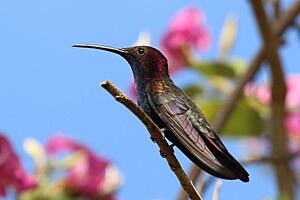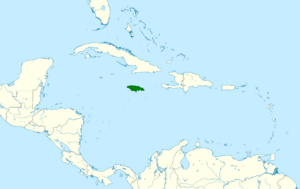Jamaican mango facts for kids
Quick facts for kids Jamaican mango |
|
|---|---|
 |
|
| At Green Castle Estate, Jamaica | |
| Conservation status | |
| Scientific classification | |
| Genus: |
Anthracothorax
|
| Species: |
mango
|
 |
|
| Synonyms | |
|
Trochilus mango Linnaeus, 1758 |
|
The Jamaican mango (Anthracothorax mango) is a beautiful type of hummingbird. It is special because it only lives on the island of Jamaica. You won't find this amazing bird anywhere else in the world!
Contents
About the Jamaican Mango
Who Discovered This Bird?
The Jamaican mango was first officially described in 1758. A famous Swedish scientist named Carl Linnaeus gave it its first scientific name. He wrote about it in his book, Systema Naturae. Linnaeus learned about this bird from drawings and descriptions by an English naturalist named Eleazar Albin. Today, the Jamaican mango is part of a group of hummingbirds called Anthracothorax.
What Does the Jamaican Mango Look Like?
The Jamaican mango is about 11 to 12 centimeters (4.3 to 4.7 inches) long. It weighs around 8.5 to 9.1 grams (0.3 ounces). This bird looks different from other hummingbirds in its group. It is mostly dark, not bright green.
Male and Female Birds
The adult male has a dull green head. The sides of its head and neck are a shiny metallic magenta color. Its back is a dull greenish-bronze. The tail feathers in the middle are dark, almost black. The other tail feathers are metallic violet with a thin dark blue band. The male's belly and chest are a velvety black.
The adult female looks similar to the male. However, her sides are a faded velvety green. She also has white tips on her outer tail feathers. Young males have a deep blue throat. This throat color changes to the adult black after their second year.
Where Do Jamaican Mangos Live?
The Jamaican mango lives all over the island of Jamaica. You can find the most birds along the northern coast. They like many different open and partly open places. This includes the edges of forests, gardens, and even farms. They also live in dry areas. However, they do not like areas with mangrove trees.
These birds usually live from sea level up to 800 meters (2,600 feet) high. Sometimes, they can be found as high as 1,500 meters (4,900 feet), but this is rare.
Behavior of the Jamaican Mango
Movement and Migration
Jamaican mangos sometimes move around the island. From June to August, they fly from higher places to middle elevations. This happens after the flowering season ends in the higher areas.
What Do They Eat?
The Jamaican mango eats two main things: nectar and arthropods (like insects). They drink nectar from many different kinds of flowers. These flowers can be on trees, bushes, or vines. Some of these plants are native to Jamaica, and some were brought there by people. Male birds often protect flowering trees. They chase away other birds that try to get nectar from their trees. The Jamaican mango also catches insects while flying.
Reproduction and Life Cycle
Jamaican mangos can build nests and lay eggs at any time of the year. However, they nest most often between January and May. They build a small, cup-shaped nest. They use soft plant fibers and fluffy seed down. They hold it all together with spider silk. The nest is usually on a thick tree branch. It is typically between 3 and 8 meters (10 to 26 feet) above the ground. The female usually lays two eggs. We don't know how long it takes for the eggs to hatch or for the young birds to leave the nest.
What Do They Sound Like?
The Jamaican mango is not a very loud bird. Its song has not been fully described by scientists. Its call is a sharp, scratchy sound. It sounds like "tic...tic...tic."
Conservation Status
The IUCN (International Union for Conservation of Nature) has looked at the Jamaican mango. They have decided that it is a species of "Least Concern." This means that it is not currently in danger of disappearing. We don't know exactly how many of these birds there are. We also don't know if their numbers are growing or shrinking. However, they are common throughout Jamaica. They also seem to do well in areas changed by people, like gardens. This suggests that losing their natural homes is probably not a big problem for them.


